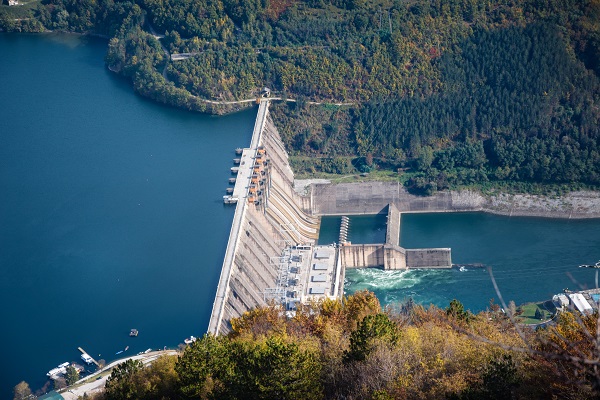Giacomo Falchetta, International Institute for Applied Systems Analysis (IIASA)
Hydropower provides clean electricity to millions in Africa. It’s the largest source of renewable energy on the continent and accounts for nearly one quarter of total electricity generation in sub-Saharan Africa.
Some countries, however, have a much heavier reliance on it than others. For instance, hydropower accounts for at least 80% of electricity generation in the Democratic Republic of Congo, Ethiopia, Malawi, Mozambique, Uganda and Zambia.
The continent has a lot more hydropower potential too. With relatively abundant water resources, sub-Saharan Africa is estimated to have 1.4 petawatt hours a year of untapped, low cost potential. To put this into perspective, 1 PWh of energy could power about half a billion households for one year, assuming each household consumes an average of about 5.5 kWh per day.
However, there are political and environmental concerns that planners must consider if they want to expand hydropower. The tensions between Ethiopia and downstream countries in the Nile River basin, following the construction of the colossal Grand Renaissance Dam, are emblematic of this.
As a researcher who studies the linkages between energy systems and climate change, I’ve written a paper that highlights why using or increasing dependency on hydropower involves climate-related risks.
The global and regional climate is getting more extreme. Events such as droughts and floods are becoming more frequent. Worryingly, energy planning and management is not keeping pace with such changes in most African countries.
Climate change threat to hydropower
Hydroelectricity is generated by harnessing the kinetic energy of water. This water may come from rivers or water that’s been stored in natural or artificial basins. Water flows through turbines which spin. The kinetic energy of the moving water is converted into mechanical energy and eventually into electrical energy.
A dam’s power output is, therefore, very sensitive to extreme changes in river and water availability. It’s also sensitive to permanent changes in the weather from when it was constructed.
I carried out an extensive review of existing studies on the projected impacts of climate change on hydropower in different areas of sub-Saharan Africa. This included its impact on output, reliability and future hydropower prospects.
I found that the impact on hydropower output varies across regions. Countries in east Africa could benefit from a wetter climate in terms of hydropower output. On the other hand, there are serious concerns that countries in southern Africa and western Africa will face a drier climate.
This would bring negative impacts. Drops in water levels mean turbines will operate at lower rates and therefore produce less electricity. Central Africa would be the least affected sub-region in terms of precipitation change and drought incidence.
The expected changes in precipitation levels and patterns are uncertain, however. Different climate models and scenarios offer a mixed picture of how the future might unfold, particularly over central and southwestern Africa.
Still, there is consensus that extreme hydrological events will increase throughout the continent with climate change. This will make power systems less reliable, unless there’s proper planning in place.
Several countries are more at risk than others because they depend largely, or entirely, on hydropower generation and have few back-up options available. These include the Democratic Republic of Congo, Ethiopia, Uganda, Zambia, Mozambique and Sierra Leone. Some might even increase their dependency on hydropower.
Only some countries have made progress in diversifying their energy mix. Kenya, for instance, has developed and continues to plan for significant alternative renewable capacity.
Planning and management of power supply
Several planning and management actions are needed to prepare for the effects of climate change on hydropower. This will ensure that citizens in sub-Saharan Africa benefit from a more reliable power supply.
First, hydropower-dependent countries need to accelerate their efforts to diversify their power mix. A new study demonstrated that African countries should increase investments in other renewable energy sources, such as solar and wind power. The study finds that in many areas, such as in the Zambezi and Niger river basins, renewables are becoming cost competitive or even cheaper than hydropower. The objective of investing in renewable sources of electricity is in line with the African Union’s Agenda 2063.
Second, countries must address inadequate power transmission infrastructure. This contributes to the lack of resilience. Countries could benefit from transboundary power trading opportunities among different sources of renewable energy. For instance dry spells, leading to reduced river streamflow, might coincide with high solar PV outputs in neighbouring countries, or vice versa. This will require both adequate generation and transmission infrastructure in different countries. It’ll also need a high level of coordination among different power producers and countries.
Finally, it’s essential to include a nexus approach in power system planning. For example, when planning new hydropower projects, policymakers must assess the future need for water in farming and cities. They should also assess the potential risks of multiple sectors needing water simultaneously.
Overall, power system planners must work with a robust framework that accounts for the inter-dependencies between hydropower, water availability and climate change in sub-Saharan Africa. Different actions can increase the resilience of hydropower infrastructure and ensure a reliable and sustainable power supply.![]()
Giacomo Falchetta, Postdoctoral Research Scholar in Energy, Climate and Environment, International Institute for Applied Systems Analysis (IIASA)
This article is republished from The Conversation under a Creative Commons license. Read the original article.
Also Read
Sustainable building materials for industrial warehouses worldwide
6 key water issues facing Africa

